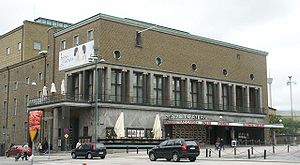
Gothenburg City Theatre
Encyclopedia

Götaplatsen
Götaplatsen is a public square in Gothenburg, Sweden, at the southern end of Kungsportsavenyn , the city's main street...
square in Gothenburg
Gothenburg
Gothenburg is the second-largest city in Sweden and the fifth-largest in the Nordic countries. Situated on the west coast of Sweden, the city proper has a population of 519,399, with 549,839 in the urban area and total of 937,015 inhabitants in the metropolitan area...
, Sweden
Sweden
Sweden , officially the Kingdom of Sweden , is a Nordic country on the Scandinavian Peninsula in Northern Europe. Sweden borders with Norway and Finland and is connected to Denmark by a bridge-tunnel across the Öresund....
. The theatre was drawn by Carl Bergsten who gave the exterior a Neo-Classical
Neoclassical architecture
Neoclassical architecture was an architectural style produced by the neoclassical movement that began in the mid-18th century, manifested both in its details as a reaction against the Rococo style of naturalistic ornament, and in its architectural formulas as an outgrowth of some classicizing...
look with a touch of Streamline Moderne
Streamline Moderne
Streamline Moderne, sometimes referred to by either name alone or as Art Moderne, was a late type of the Art Deco design style which emerged during the 1930s...
. The critics thought it to be a too old-fashioned building – the International Style
International style (architecture)
The International style is a major architectural style that emerged in the 1920s and 1930s, the formative decades of Modern architecture. The term originated from the name of a book by Henry-Russell Hitchcock and Philip Johnson, The International Style...
had had a big breakthrough some years before at the 1930 Stockholm Exhibition
Stockholm International Exhibition (1930)
The Stockholm Exhibition was an exhibition held in 1930 in Stockholm, Sweden, that had a great impact on the architectural styles known as Functionalism and International Style....
. But the interiors of the building pleased the reviewers who thought the auditorium to be "intimate" and “democratic”. The theatre went through a major renovation some years ago and the auditorium was equipped with new technology and with new seats.
The big stage has a capacity of 600 people; there is also a smaller stage called the Studio.
Many of Sweden's big theatre profiles have passed the gates of the theatre: Gösta Ekman (senior)
Gösta Ekman (senior)
Gösta Ekman, Sr. , born Frans Gösta Viktor Ekman, was a Swedish actor. Generally spoken of as Swedish theatre's most legendary stage actor, Gösta Ekman enjoyed a prolific stage career during his short life, becoming the first real star of Swedish theatre...
and Ingmar Bergman
Ingmar Bergman
Ernst Ingmar Bergman was a Swedish director, writer and producer for film, stage and television. Described by Woody Allen as "probably the greatest film artist, all things considered, since the invention of the motion picture camera", he is recognized as one of the most accomplished and...
, just to mention two of them. And during the Second World War Torsten Hammarén made the theatre famous for its anti-Nazi productions. The current leader of the theatre is Anna Takanen and before that it was run by Bosnian-Swedish director Jasenko Selimovic, who during a ten-year period managed to please both audience and theatre critics.

